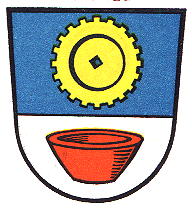Grubweg
Grubweg is a district of Passau that extends to the area of the former municipality of Grubweg in the northeast of the city of Passau.
history
Rural community
For a long time, today's urban area, which was of little importance for a long time, belonged to the bishopric of Passau and after secularization in Bavaria was initially divided between the Electorate of Bavaria and the Grand Duchy of Tuscany until it became the Kingdom of Bavaria in 1805 . Even today, a boundary stone on the Fuchsberg reminds of the Tuscan-Bavarian border.
In 1808 a tax district and in 1818 a municipality Grubweg was formed . The towns of Lindau, Ziegelreuth, Kastenreuth and Lüfteneck also belonged to it. Until the Second World War , Grubweg remained a quiet rural community at the gates of Passau. In 1939 it had 1,372 inhabitants.
expansion
That changed on June 1, 1943, when the Waldwerke GmbH Passau opened at the instigation of ZF Friedrichshafen , where gearboxes for tanks were produced. The plant employed 1200 people, including 333 internees from the Mauthausen concentration camp , for whom a separate sub-camp was set up.
After the end of the war there was a refugee camp on the factory premises. On August 12, 1946, ZF Friedrichshafen founded ZF Passau GmbH at the Waldwerke site . This developed into the largest company in the Passau area, the number of employees grew from initially 150 to 3000 in 1957. The purely rural community became an expanding suburban community.
In 1950 the first emergency school was built, in 1953 the first school building. In 1952 the TSV Grubweg was founded, which merged on December 17, 1954 with the ESV Passau to form VFB Passau-Grubweg. The first emergency church was also consecrated in 1953, and in 1957 a pastoral care center was established for the Passau parish of St. Bartholomew. In 1957 the agricultural vocational school was built and in the same year the Protestant parish church of St. Johannes. According to the plans of Hans and Traudl Maurer, the Catholic parish church of St. Michael was built between 1958 and 1960, a modern round building equipped by Leopold Hafner . 1961 followed the elevation to the parish. In 1963 a new town hall and a new fire extinguishing equipment house were added. The cemetery was laid out in 1967 and the large colored windows of the church were added in 1970.
Incorporation
Already during and shortly after the Second World War, the city of Passau made efforts to incorporate them, but at that time they were not seen as urgent. The plans were only implemented in the course of the regional reform . But the meanwhile very self-confident Grubweg offered resolute resistance. In a public survey in August 1971, with a turnout of 78.5%, no less than 95.5% were against incorporation into Passau. When on May 10, 1972 the incorporation of Grubweg into Passau was ordered by government decree, the municipality filed a constitutional complaint with the Bavarian Constitutional Court . On May 6, 1972, its Senate announced that the government's order for overriding interests was legal and that the incorporation was finally decided. On July 1, 1972, the incorporation became legally effective.
Further development
The DJK-TC Passau-Grubweg was founded in 1977. In 2008, a total of 8198 residences were registered in Grubweg, of which 7202 main and 996 secondary residences.
Districts
The district is further subdivided into nine districts:
|
|
|
Mayor of the municipality
|
|
literature
- Franz Mader : The history of the incorporation after Passau (= Der Passauer Wolf. Series of publications of the Passau City Archives. Vol. 7). City archive, Passau 1997, ISBN 3-929350-29-7 .
Individual evidence
- ^ Wilhelm Volkert (ed.): Handbook of Bavarian offices, communities and courts 1799–1980 . CH Beck, Munich 1983, ISBN 3-406-09669-7 , p. 602 .
Coordinates: 48 ° 35 ' N , 13 ° 29' E



